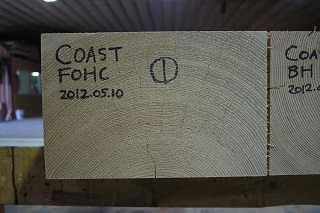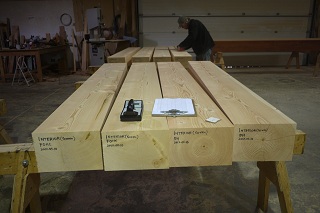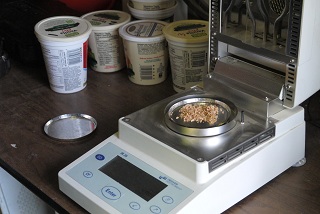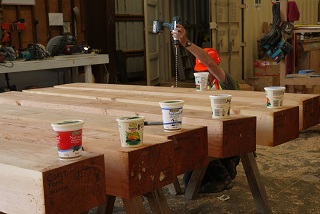Latest test: timber drying
From Daizen News July 2012
Timber is tricky, and to achieve predictable, consistent results, Daizen specializes in controlling it. Many people don’t understand how wood can be so varied in its behavior: wood is wood, right? Well, in fact, there are many, many variables. Wood fiber is a natural product. No two trees, even of the same species, are exactly the same; timbers behave differently in different drying processes (air or kiln dry, for example).
Part of our timber drying test.
To clarify how we evaluate information, we conducted a test of kiln drying behavior, comparing two species of Douglas fir (coastal and interior) that we use very frequently. We compared wood from two locations on each tree (boxed heart: BH; free of heart center: FOHC) and, for the interior D. fir, we also compared two stages of dryness:green—live when cut—and standing dead (SD). (Coastal D. fir is not subject to as many fires, since it’s much wetter.)
Timbers are planed square, to exact size, in order to monitor the changes after drying.
The coast’s mild, rainy climate causes trees to grow larger and faster. In the interior’s climate, colder winters and hotter summers make for slow growth and very tight winter growth rings, which in turn means the fiber is denser than the coastal version.
We took samples by drilling to the core and placing the chips into sealed containers so as not to lose moisture.
We prepared six timber samples (coastal D. fir: BH and FOHC; interior D. fir: BH green and SD; FOHC green and SD) and planed them to the exact same size (7½ x 11½ in.) to measure the dimension loss—shown in this PDF chart in the “After drying” row. This chart is a comprehensive report of all our test results.
Timber Drying Test chart (PDF)
A normal moisture meter gives only an indication of moisture, not a precise reading. Moisture varies even in different spots in one timber; accuracy requires taking several readings to arrive at an average read. The most accurate measure comes from several readings plus measuring the weight difference after drying.
This moisture meter measures the weight difference before and after drying in its built-in oven. It also calculates for moisture content. This can also be done with an accurate scale and a microwave at home.
Since BH timber often splits lengthwise, kiln drying it may result in dryer timber since more surface area is open to moisture escaping. So we tested both BH and FOHC timber, for further comparison.
Our conclusions: if kiln drying, coastal Doug fir gives better results, but interior Doug fir may perform better in air drying. We have several test sets in air drying now; the full cycle will take two to three years, and we are measuring every couple of months.
Samples resting on their timbers after kiln drying.
Interested in finding out more?
At Daizen, we ensure client expectations and understanding of processes are met through all phases of our work, from structural design and engineering to fabrication of timber frames and assembly and installation.




